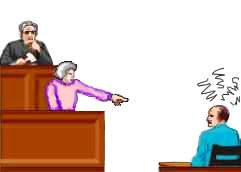|
Listing and Nulling starts with
a carefully formulated question, which
is designed to get one and only one final answer from the pc. That basic
or final answer is called The Item.
The auditor will have a question like: "Who or
What......?"
(Example (not an actual auditing question): "Who or What have you
tried to compete with?")
The auditor will check the question for read before he engages in Listing.
He then asks the pc the question and writes down the list of items
(answers) from
pc. When he has a list and pc apparently has given all the items he could
find the auditor narrows it down to one item. Usually this is a very easy
procedure in modern auditing. Sometimes it takes a little more work. The
exact actions of how to nail it down to one item are covered in the Laws
of Listing & Nulling.
There are thus two phases in Listing & Nulling:
There is the Listing: The auditor asks the Listing question and
writes down the all the answers pc has in response to this question.
There is Nulling: The auditor reads this list back to the pc to
narrow it down to one charged and final answer. When he has found that, he
gives pc his item and it should get a BD F/N VGI on the pc.
Example: The Listing question is:
"Who or What caused the car accident?" (F)
The auditor has a reading L&N question and asks pc:
"Who or what caused the car accident?"
Pc gives a list in response:
| The clutch |
x |
|
|
| The weather |
x |
|
|
| The stray dog |
SF |
|
|
| The bad breaks |
SF |
|
|
| The passenger |
x |
|
|
| The driver |
F |
|
|
The auditor has a list with 3 reads. He now nulls
this list by reading it back to pc (reads in column N1):
| Items: |
L1 |
N1 |
|
| The clutch |
x |
x |
|
| The weather |
x |
x |
|
| The stray dog |
SF |
SF |
|
| The bad breaks |
SF |
x |
|
| The passenger |
x |
SF |
|
| The driver |
F |
F |
|
| |
|
|
|
The auditor has more than one reading item on
Nulling the list. Per the Laws of L&N he extends the list. This is
done by asking the question again: "I am going to extend the
List". "Who or what caused the car accident?" The new
answers are below the Extend line (reads marked in Lx column):
| Items: |
L1 |
N1 |
Lx |
| The clutch |
x |
x |
|
| The weather |
x |
x |
|
| The stray dog |
SF |
SF |
|
| The bad breaks |
SF |
x |
|
| The passenger |
x |
SF |
|
| The driver |
F |
F |
|
| EXTEND -------- |
| Blinding sun |
|
|
F |
| Dog owner |
|
|
SF |
| |
|
|
|
The auditor now nulls the whole list, including the
extension (reads marked in N2 column):
| Items: |
L1 |
N1 |
Lx |
N2 |
| The clutch |
x |
x |
|
x |
| The weather |
x |
x |
|
x |
| The stray dog |
SF |
SF |
|
x |
| The bad breaks |
SF |
x |
|
x |
| The passenger |
x |
SF |
|
x |
| The driver |
F |
F |
|
x |
| EXTENDED -------- |
|
| Blinding sun |
|
|
F |
x |
| Dog owner |
|
|
SF |
F |
| |
|
|
|
|
The list now has only one reading item on second
Nulling. The auditor assumes that this is The Item.
He asks pc: "Is 'Dog owner' your Item?"
Pc answers: "Yes!" with a BD F/N VGI's.
The auditor says: "I want to indicate 'Dog Owner' is your Item".
He marks this clearly on his list.
Admin
L&N actions are always kept on a separate sheet of paper. The list
is paper-clipped to the session report. This is important since L&N
actions sometimes are reviewed later - either for verification or
correction. You write the pc's name, the date, the exact L&N question
with read at the top. You always cycle the Item with a pen and write
Indicated to pc (IND), if you did so. Also the resulting Meter reaction.
You will still keep track of doing the action and what pc said in
addition, reactions and indicators in your work sheets. The List should
just contain the raw data:
| Pc: N.N.
Date: xx/xx/xx |
| W/W caused the car accident?
(F) |
| Items: |
L1 |
N1 |
Lx |
N2 |
| The clutch |
x |
x |
|
x |
| The weather |
x |
x |
|
x |
| The stray dog |
SF |
SF |
|
x |
| The bad breaks |
SF |
x |
|
x |
| The passenger |
x |
SF |
|
x |
| The driver |
F |
F |
|
x |
| EXTENDED-------- |
|
| Blinding sun |
|
|
F |
x |
| >Dog owner< |
|
|
SF |
F |
| Indicated to pc |
2.8-2.6 |
BD |
FN |
VGI |
| |
|
|
|
|
General About L&N
Early on in Scn, the action of L&N was poorly understood. According to
a lecture by R. Hubbard in 1962, a list could go on and on. As many as
2,500 items were reported! In modern auditing more than 5-10 items are
unusual. Many times the listing question will go to BD F/N VGI item very
quickly without even have to null the list. The next chapter about the
Laws of Listing & Nulling contains the exact procedure with some
examples.
Let us here just make some remarks about the nature
of L&N questions. You have to understand they are highly charged
questions. But if the pc is fully set up for the action and a standard
question is used it is usually a quick and easy action to audit.
Errors in finding the right Item can however cause
serious upsets in session. L&N #12 states:
12. "An underlisted and overlisted list will ARC break the pc and he
may refuse to be audited until the list is corrected, and may become
furious with auditor and will remain so till it is corrected."
 |
Romantic love seems to
follow the Laws of L&N.
A question like
"Who is my true soul mate?"
calls for 'only one reading
Item on the List'.
|
Let's illustrate that with some examples from life.
There are some situations in life which seem to follow the Laws of Listing
and Nulling. Both the examples we use are well known from life and
literature:
You have the romantic idea that there is one single partner in life you
should marry. According to romantics there is such a person and only one,
who is "my true soul mate". This is very close to an L&N
action. Let's say a man is looking for the woman meant for him. He finally
finds her - the BD F/N VGI Item - his soul mate. But now we can only hope,
that he is the BD F/N VGI Item for her. With this you can view the bliss
and the utter upsets that happen in the field of finding the right one;
and possibly later on, if they find out "They were not meant for each
other", you find an explanation for all the blow-ups that also can
happen according to L&N Law #12 above. It seems like the rule in the
case of a couple breaking up is, they are automatically worst enemies all
of a sudden. We will not here go into a long discussion of what of all
this is justified or not. A better approach to a relationship is probably
to work on it based on increasing ARC. But it is an illustration of why
you want only one item on the list - the right one - when you are done.
 |
Being wrongly accused or
convicted is a 'Wrong Item'
to the defendant. It can have
deadly consequences.
|
Another illustration of L&N is a criminal
investigation. You want to find the guilty part and put him behind bars in
case of a serious crime. In a less serious crime you want to expose him
and know not to trust him. Let's say you had a serial killer. The police
wants to hunt him down and put him behind bars so he will kill no more.
Arresting somebody "who fits the profile" isn't good enough. The
person wrongly accused will see his life ruined (he is getting hung with a
wrong item). The criminal will still be out there and more murders will
happen. The police has a Wrong Item for their investigation. When they
finally get the killer, on the other hand, they have the Right Item. The
random murders will stop and everybody around can feel safer and better -
including other suspects.
L&N is sometimes used as Why Finding. The Real
Why is defined as the biggest aberration from the Ideal Scene. This means,
when you have isolated the Real Why you can turn the situation around. If
you find the Wrong Why and act upon it things may turn a lot worse. So
L&N is powerful stuff. Done right on a pc ready for it and with a
standard question, it works real well and is easy to do.
|











